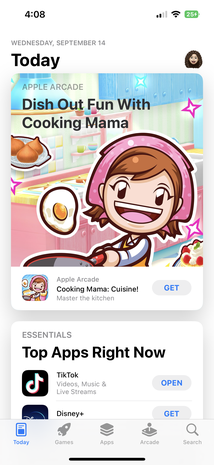
The App Store is an app marketplace developed and maintained by Apple, for mobile apps on its iOS and iPadOS operating systems. The store allows users to browse and download approved apps developed within Apple's iOS SDK. Apps can be downloaded on the iPhone, iPod Touch, or iPad, and some can be transferred to the Apple Watch smartwatch or 4th-generation or newer Apple TVs as extensions of iPhone apps.
Dropbox is a file hosting service operated by the American company Dropbox, Inc., headquartered in San Francisco, California, U.S. that offers cloud storage, file synchronization, personal cloud, and client software. Dropbox was founded in 2007 by MIT students Drew Houston and Arash Ferdowsi as a startup company, with initial funding from seed accelerator Y Combinator.
Swype was a virtual keyboard for touchscreen smartphones and tablets originally developed by Swype Inc., founded in 2002, where the user enters words by sliding a finger or stylus from the first letter of a word to its last letter, lifting only between words. It uses error-correction algorithms and a language model to guess the intended word. It also includes a predictive text system, handwriting and speech recognition support. Swype was first commercially available on the Samsung Omnia II running Windows Mobile, and was originally pre-loaded on specific devices.

Instagram is an American photo and video sharing social networking service owned by Meta Platforms. It allows users to upload media that can be edited with filters, be organized by hashtags, and be associated with a location via geographical tagging. Posts can be shared publicly or with preapproved followers. Users can browse other users' content by tags and locations, view trending content, like photos, and follow other users to add their content to a personal feed. A Meta-operated image-centric social media platform, it is available on iOS, Android, Windows 10, and the web. Users can take photos and edit them using built-in filters and other tools, then share them on other social media platforms like Facebook. It supports 32 languages including English, Hindi, Spanish, French, Korean, and Japanese.

WhatsApp is an instant messaging (IM) and voice-over-IP (VoIP) service owned by technology conglomerate Meta. It allows users to send text, voice messages and video messages, make voice and video calls, and share images, documents, user locations, and other content. WhatsApp's client application runs on mobile devices, and can be accessed from computers. The service requires a cellular mobile telephone number to sign up. In January 2018, WhatsApp released a standalone business app called WhatsApp Business which can communicate with the standard WhatsApp client.

Messenger, also known as Facebook Messenger, is an American proprietary instant messaging service developed by Meta Platforms. Originally developed as Facebook Chat in 2008, the client application of Messenger is currently available on iOS and Android mobile platforms, Windows and macOS desktop platforms, through the Messenger.com web application, and on the standalone Facebook Portal hardware.
Snapchat is an American multimedia instant messaging app and service developed by Snap Inc., originally Snapchat Inc. One of the principal features of the multimedia Snapchat is that pictures and messages are usually available for only a short time before they become inaccessible to their recipients. The app has evolved from originally focusing on person-to-person photo sharing to presently featuring users' "Stories" of 24 hours of chronological content, along with "Discover", letting brands show ad-supported short-form content. It also allows users to store photos in a password-protected area called "My Eyes Only". It has also reportedly incorporated limited use of end-to-end encryption, with plans to broaden its use in the future.

Vine was an American short-form video hosting service where users could share up to 6-second-long looping video clips. Founded in June 2012 by Rus Yusupov, Dom Hofmann and Colin Kroll, the company was bought by Twitter, Inc., four months later for $30 million. Vine launched with its iOS app on January 24, 2013, with Android and Windows versions following.

Hyperlapse or moving time-lapse is a technique in time-lapse photography for creating motion shots. In its simplest form, a hyperlapse is achieved by moving the camera a short distance between each shot. The first film using the hyperlapse technique dates to 1995.

Digg Reader was a news aggregator operated by Digg. The reader was released on June 26, 2013 as a response to Google Reader shutting down. The reader was web-based and also had iOS and Android applications as well as a Google Chrome extension. The beta for the reader has received mostly positive reviews. On March 26, 2018, Digg shut down Digg Reader.

Chromecast is a discontinued line of digital media players developed by Google. The devices, designed as small dongles, can play Internet-streamed audio-visual content on a high-definition television or home audio system. The user can control playback with a mobile device or personal computer through mobile and web apps that can use the Google Cast protocol, or by issuing commands via Google Assistant; later models introduced an interactive user interface and remote control. Content can be mirrored to video models from the Google Chrome web browser on a personal computer or from the screen of some Android devices.
Google Cast is a proprietary protocol developed by Google for playing locally stored or Internet-streamed audiovisual content on a compatible consumer device. The protocol is used to initiate and control playback of content on digital media players, high-definition televisions, and home audio systems using a mobile device, personal computer, or smart speaker. The protocol was first launched on July 24, 2013, to support Google's first-generation Chromecast player.

Facetune is a photo and video editing application used to edit, enhance, and retouch photos on a user's iOS or Android device created by Lightricks. The app is often used for portrait and selfie editing.

iOS 8 is the eighth major release of the iOS mobile operating system developed by Apple Inc., being the successor to iOS 7. It was announced at the company's Worldwide Developers Conference on June 2, 2014, and was released on September 17, 2014. It was succeeded by iOS 9 on September 16, 2015.

TestFlight is an online service for over-the-air installation and testing of mobile applications, currently owned by Apple Inc. and only offered to developers within the iOS Developer Program. Developers sign up with the service to distribute applications to internal or external beta testers, who can subsequently send feedback about the application to developers. The TestFlight SDK additionally allows developers to receive remote logs, crash reports and tester feedback.

VSCO, formerly known as VSCO Cam, is a photography mobile app for iOS and Android devices. The app was created by Joel Flory and Greg Lutze. The VSCO app allows users to capture photos in the app and edit them, using preset filters and editing tools.

IGTV, short for Instagram TV, was a video application by Instagram for Android and iOS smartphones. It allowed for longer videos compared to Instagram feeds. IGTV was available as a stand-alone app, though basic functionality was also available within the Instagram app and website.

Eyegroove was a social media service headquartered in San Francisco for creating short music videos with augmented reality effects founded by Scott Snibbe and Graham McDermott. The company was established in 2013 and released the first version of its app on iOS that year. Through the app, users could create thirty second creative and lip-syncing music videos and choose musical tracks to accompany them, use different speed options and add time-based augmented reality filters and effects. The app's social media features included an Instagram-like feed, hashtags for creative memes, user tagging, and comment threads.













